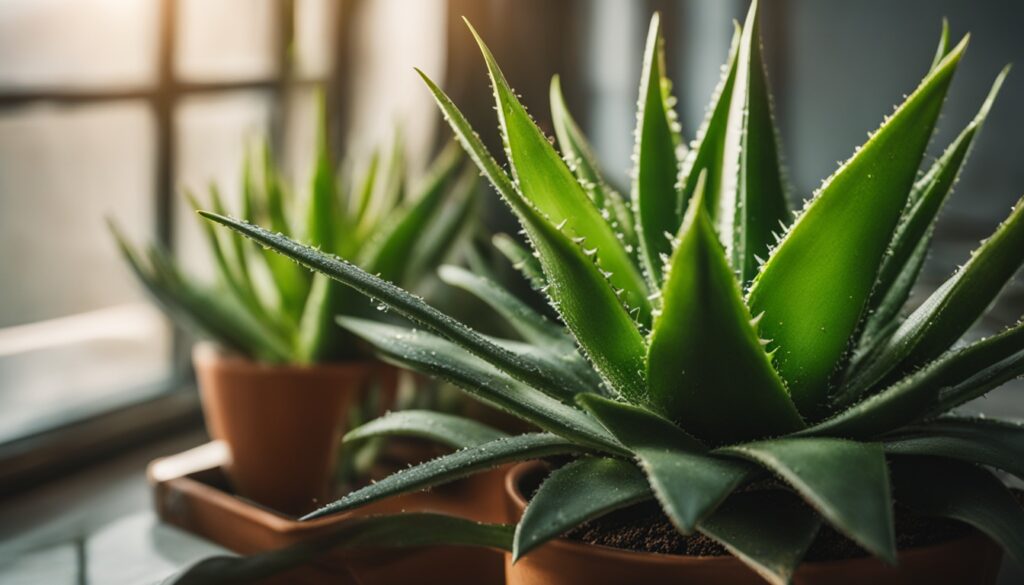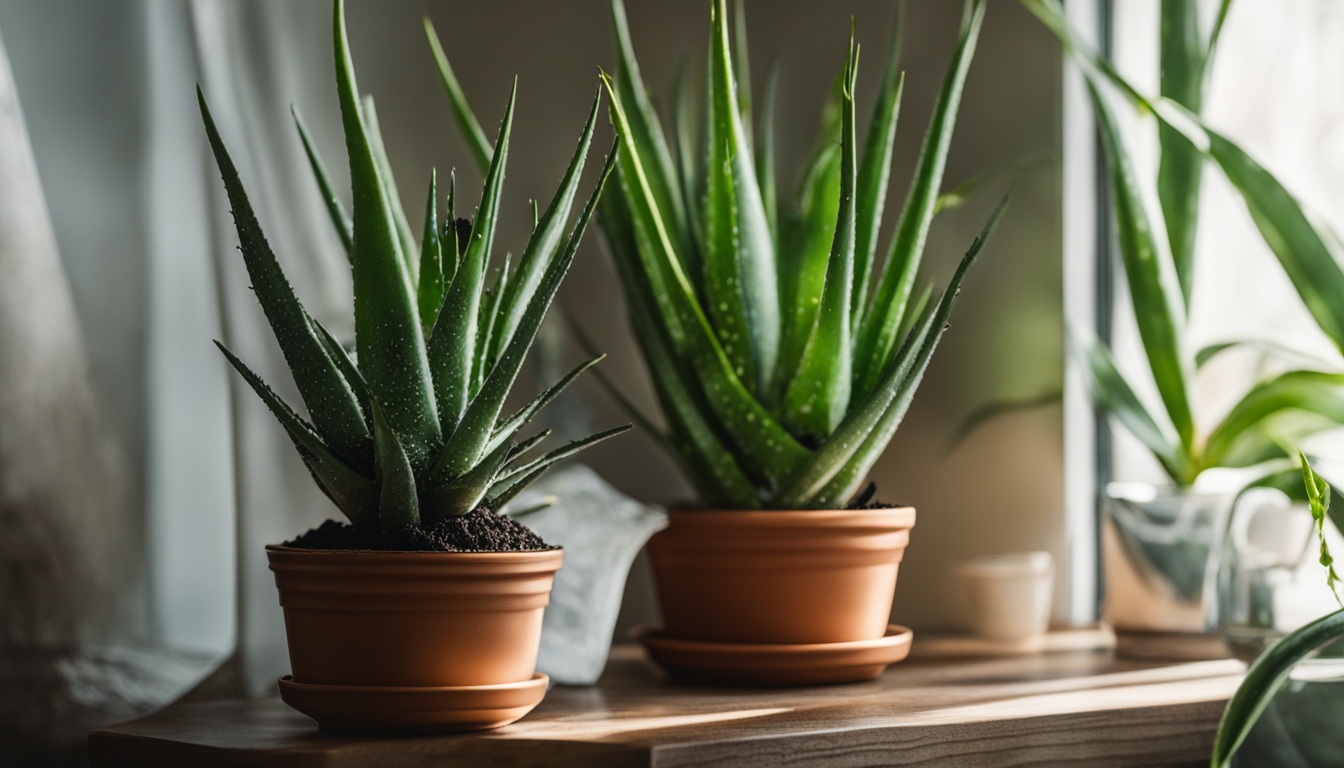Ralph Waldo Emerson once said, “The creation of a thousand forests is in one acorn.” In indoor gardening, caring for a single aloe plant can bring big rewards. These plants not only look great but also make the air cleaner, making your home healthier. This guide will teach you how to keep your aloe plant healthy and full of life. By knowing the best conditions for your aloe and using the right care tips, you can have a beautiful plant in your home.
Key Takeaways
- Aloe plants thrive in bright, indirect sunlight and need minimal watering.
- Using the right potting soil and container enhances drainage and overall plant health.
- Regular monitoring for pests can prevent larger issues down the road.
- Fertilization is recommended only during the growing season for optimum health.
- Your indoor environment plays a crucial role in the growth of aloe plants.
Understanding Aloe Plants and Their Ideal Environment
To take good care of aloe vera plants indoors, you need to know about the different types that do well inside. Choosing the right kind is key for their health and looks.
Types of Aloe Plants Suitable for Indoor Growth
Some top picks for indoor aloe plants are:
- Aloe Vera: This succulent is loved for its healing qualities.
- Aloe Arborescens: It has beautiful leaves, adding to your home’s look.
- Aloe Polyphylla: Its spiral leaves make it stand out.
Optimal Lighting Conditions for Your Aloe Plant
Aloe plants love bright, indirect sunlight. Place your plant near a sunny window but not in direct sunlight to prevent burn. The right light is key for your aloe’s success indoors.
Choosing the Right Pot and Soil for Aloe Needs
For indoor aloe plants, picking the right pot and soil is important. Use pots with holes to prevent water from pooling. A mix with sand, perlite, or cactus soil is best to stop root rot. The right pot and soil help your aloe plants stay healthy.

Learning these tips will help you care for your aloe plants better. Pay attention to each type’s needs for the best indoor garden.
Aloe Plant Care Indoor Essentials for Thriving Growth
Looking after an indoor aloe plant means paying close attention to a few key areas. Focus on the right watering, fertilizing, and pest control methods. This will help keep your houseplant healthy. Here are the main guidelines you should follow:
Watering Guidelines for Indoor Aloe Plants
For the best care, set a watering schedule that matches your aloe’s needs. Aloe plants do well with less water. Water your aloe every 2-3 weeks, letting the soil dry out fully between times. Too much water can cause root rot, which is bad for your plant.
Fertilization Tips for A Healthy Aloe Plant
Knowing how to feed your aloe plant is key. Use a weak cactus fertilizer only during the growing season, in spring and summer. Don’t fertilize more than once a month, as too many nutrients can stress your plant.
Pest Control and Disease Prevention Strategies
Keep your indoor aloe plants pest-free by staying alert. Pests like mealybugs and spider mites can harm your plant. Use insecticidal soap to prevent pests and keep humidity levels right to avoid diseases. Check your plants often for any signs of trouble or pests.

By following these tips, you’ll create a great home for your aloe plant.
Best Indoor Aloe Plant Care Tips for Longevity
To keep your indoor aloe plant healthy, watch for common problems early. Yellow leaves mean you’re watering too much, while shriveled leaves mean you’re not watering enough. By watching how your plant grows and adjusting your watering, you can give it the right care.
How to Identify and Address Common Aloe Plant Issues
Issues like soggy soil and pests can harm your aloe plant. Look out for these signs:
- Yellowing leaves: Means you’re watering too much, which can cause root rot.
- Brown spots: Could be from sunburn or a bacterial infection.
- Soft, mushy leaves: Comes from too much moisture and might mean disease.
Fix these problems by having a good watering schedule for your aloe plant. Water it less often but make sure it gets enough water. This is especially true during the winter when it’s dormant.
Seasonal Care Adjustments for Indoor Aloe Plants
Seasonal care is crucial for aloe plants. In spring and summer, you might need to water more often. But in fall and winter, water less to avoid over-saturation. Also, turn your plants now and then to help them grow evenly and get enough light.
Repot your aloe plant every few years to give it fresh soil and room to grow. With regular repotting and seasonal care, your aloe plant will thrive. Knowing how to care for it is the secret to its success1.
Conclusion
To keep your aloe plants happy indoors, you need to know what they need. Give them the right light, pick the best soil, and water them correctly. These steps help your aloe plants grow strong and healthy at home.
Managing pests and adjusting for the seasons is also key. These steps keep your aloe plants lively. By focusing on these areas, you make a great place for your plants to grow. Caring for your plants also makes you feel better, adding to your mental health.
Use the tips from this article to make your indoor garden a peaceful spot for your aloe plants and a happy place for you. By taking good care of your aloe plants, you’ll enjoy a beautiful indoor garden2!
FAQ
What are the basic care tips for indoor aloe plants?
How often should I water my aloe plant indoors?
What type of potting soil is best for aloe plants?
What are the signs of overwatering or underwatering an aloe plant?
Can aloe plants thrive in low light conditions?
How can I prevent pests from affecting my indoor aloe plant?
When should I fertilize my indoor aloe plants?
How do I know if my aloe plant needs repotting?
Source Links
- Follow This Easy Guide to Grow Beautiful Desert Rose Plants – https://www.thespruce.com/grow-desert-rose-plants-indoors-1902974
- ‘A secluded cabin in the woods changed my life forever’ – https://www.countryliving.com/uk/wellbeing/a61775165/global-nature-study-results-surprised-me/

